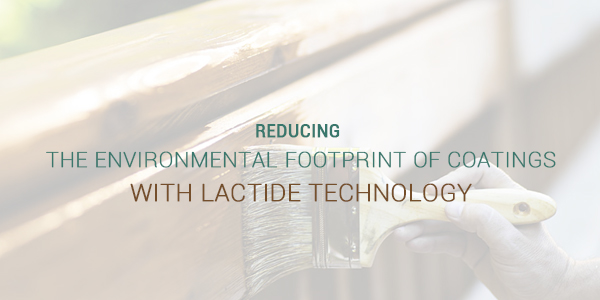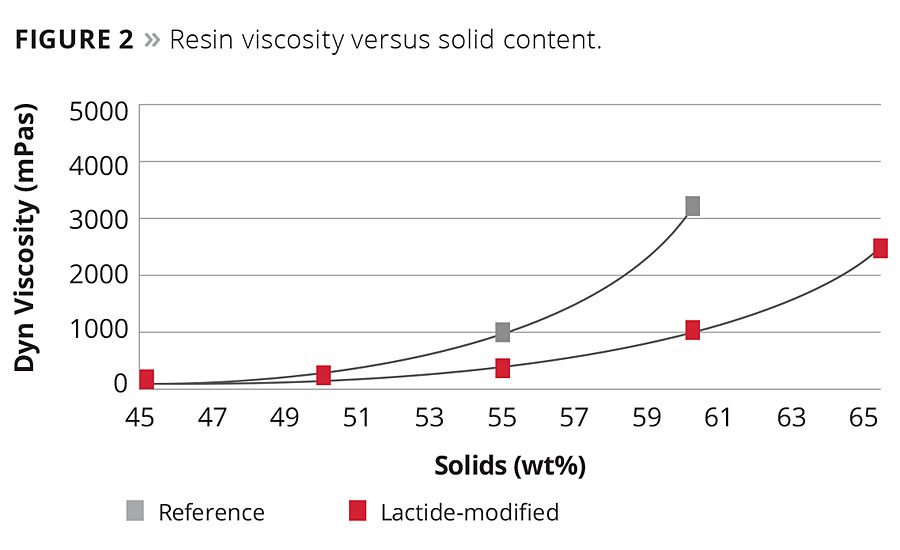Industry News, Coatings
Reducing the Environmental Footprint of Coatings with Lactide Technology

Industry News, Coatings

Link: Reducing the Environmental Footprint of Coatings with Lactide Technology | PCI
By: Dr. Armin Michel
Sustainability is a hot topic in paints and coatings. Biobased products have moved from the niche to the mainstream over the past two decades, as the sector finds itself under increasing pressure to comply with ever more stringent environmental controls. In the United States, the Environmental Protection Agency has established clear guidance relating to emissions that must be adhered to by manufacturers and their suppliers. Major industry players are also arriving at the realization that a reduced environmental footprint provides a competitive advantage in a saturated market.
It is not only in mature economies where demand for more sustainable coatings is on the rise due to more stringent legislation and sustainability targets. The paint industry in China continues to undergo rapid change and, as far back as 2011, the improved environmental performance of the coatings industry was identified as a goal in China’s 12th Five Year Plan. The real step change, however, came in early 2015. The new Environmental Protection Law was published in January and made law on February 1, as part of ongoing government efforts to improve air quality across China through the establishment of emissions standards. The legislation had a direct impact on the coatings industry and has set a precedent for other countries in less mature markets across Asia-Pacific and Latin America to follow. Biobased technologies are coming to the fore as a result, with new research highlighting the potential of lactide-modified alkyd resins in particular to formulate solvent-reduced coatings.
There are numerous variables to consider when looking to reduce the emissions content of coatings products. The volatile organic compound (VOC) content is an increasingly important factor. The current VOC limits differ from region to region and also between raw materials and final formulations, with a variation in definitions, limits and calculations across the world. For example, in the United States and Canada, a VOC is broadly defined as any compound of carbon, excluding carbon monoxide, carbon dioxide, carbonic acid, metallic carbides or carbonates and ammonium carbonate, which participates in atmospheric photochemical reactions. In the European Union (EU), the boiling point rather than the volatility is the key factor. A VOC is defined as any organic compound with an initial boiling point less than or equal to 250 °C, measured at a standard atmospheric pressure of 101.3 kPa. It is important for formulators to know the parameters that need to be tested to be in accordance with the required emissions standards in different regions.
It may now have been a year ago, but the introduction of the new Environmental Protection Law in China remains a hot topic across the global coatings industry. As part of the legislative changes, new regulations were introduced to reduce the emission of VOCs into the atmosphere – including the imposition of a 4% tax on manufacturers on the invoice price of any coating where the ready-to-spray VOC level exceeds 420 g/L. China defines VOC using a very similar definition to that adopted in the EU. The guidance is known formally as ‘Finance Tax (2015) Notification on Imposing Consumption Tax on Battery and Coating Products’.
The speed at which the government in China brought the new Environmental Protection Law into force made waves across the global coatings industry. Coatings manufacturers and their suppliers had to act very quickly to comply with the new official requirements. It is also looking likely that other economies with strong growth prospects will follow in the footsteps of China. At present, there are no mandatory VOC regulations in Latin America, but the situation is currently being reviewed in Brazil, Argentina and Mexico amongst others.
The global market for coatings with low or zero VOC content, valued at approximately $60.6 billion in 2012, is now forecast to reach $85.7 billion by 2018, with a growing array of waterborne, powder, high-solids and radiation-curable products available. Performance, however, remains a fundamental requirement. This is the reason why alkyd resins have been used for many years to produce solvent-based coatings. Indeed, solvent-based paints are still widely used in metal and wood coating applications and retain excellent gloss, flow and levelling characteristics.
Reformulating solvent-based coatings to high-solid systems is the solution to meet targets for lower VOC content, without compromising on the required performance. Extensive research has been conducted to identify monomers that can be incorporated into polymers and resins to enhance the properties of both resin and coating. The unique biobased building block lactide is an example of such an innovative technology, with benefits such as shorter drying time, improved hardness and excellent gloss retention. The novel chemical structure of lactide provides equal or better coatings performance compared to petrochemical alternatives, while also reducing the environmental impact of solvent-based coatings.

Data shows that lactide-modified alkyd resins give a significant reduction in viscosity compared to reference resins, while retaining the rheological behavior of the polymer resin. Tests show that the use of lactides in medium-oil alkyd resins results in a reduction in the viscosity of up to 80% at comparable molecular weight (Figure 1). The reduced resin viscosity can be used to increase the solid content of the paint formulation at the same viscosity, and the rheological behavior of the polymer resin is retained. The amount of solvent required is therefore significantly reduced (Figure 2) and, with a higher material content per volume ratio, the VOC content is lower in higher-solid paint formulations. There is up to 30% less solvent in certain resin formulations and this also reduces raw material costs.

In fact, the environmental advantages of lactide-modified alkyd resins span beyond reduced VOC content. By replacing fossil fuel-based monomers with lactide, the renewable content of the resin increases. This can reduce the carbon footprint of alkyd resins by up to 21%, depending on the raw materials used to help achieve a reduction in CO2 emissions. In addition, data shows that the amount of reaction water – or condensation – can be reduced by 10% compared to reference systems as a result of the ring opening polymerization of lactide. By reducing the amount of water produced during the polymerization process, the waste water stream is minimized. The water is usually polluted and so a reduction in waste water is better for the environment and also saves treatment costs.
Lactide can be incorporated into alkyd-based resins in a cost-competitive manner, using existing production processes and without compromising on the performance of both resin and coating. The formulation is modified by using lactides to replace a combination of di-functional glycols and diacids, while maintaining the properties of the resin such as acid and hydroxyl value and molecular weight. The enhanced resin efficiency is not only better for the environment, but also improves initial hardness development to result in shortened drying time. Lactide-modified alkyd resins demonstrate similar initial gloss values compared to reference resins, and gloss retention also showed a similar yellowing profile over four weeks when measured at a storage temperature of 50 °C.
Lactide-based alkyd resins can help coatings formulators to meet new targets for lower VOC content and produce coatings with a reduced carbon footprint. Corbion’s product, PURALACT® B3, is a unique and highly purified lactide. By exhibiting lower resin viscosity, PURALACT B3 introduces the possibility of producing high-solid formulations that can meet strict VOC regulations. Other environmental benefits include reduced reaction wastewater and an increased proportion of renewable content in the resin. It provides equal or better coating performance compared to traditional solvent-based coatings – for example, offering shorter drying time, improved hardness and gloss retention. PURALACT B3 is commercially available at a grade optimized for the coatings market and can be easily incorporated into alkyd resins.
Copyright of this article by PCI. We are sharing and promoting the market innovation.
If you like this article, kindly to visit www.pcimag.com